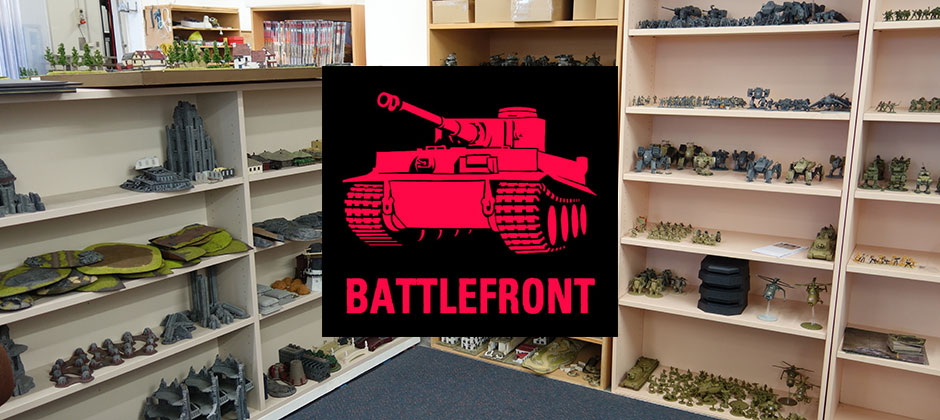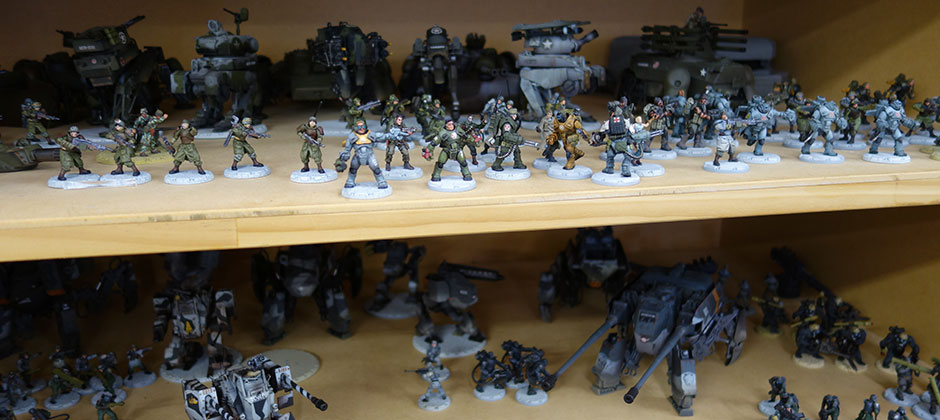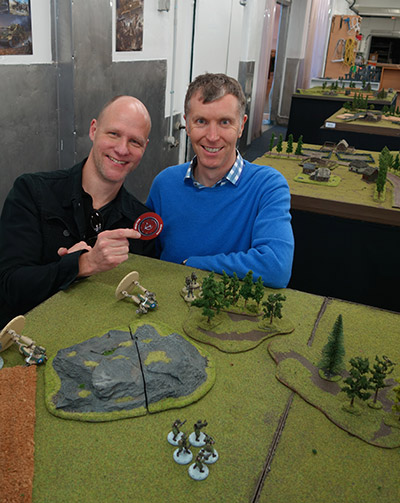
Hell, these guys deserve to go home as much as I do. They’ve fought just as hard.
Infiltrating the Battlefront Miniatures office, Universal Head sends back this report about the company behind Flames of War, Dust, and Gale Force Nine products.
 The office of Battlefront Miniatures is a tricky place to find. No signage betrays their location in a converted fishery building on a renovated section of the Auckland waterfront, surrounded by bars, restaurants and new units. I walked tentatively upstairs to the building’s reception, where only a small glass cabinet with a few miniatures in it told me I was in the right place. Soon, a tall, smiling man all dressed in black came through a door to greet me, his hand outstretched—Chris Townley, Battlefront’s Studio Manager. He ushered me into an office space where I felt immediately at home, surrounded by fellow gamers and the organised chaos of game development. Shelves and shelves of gaming books, miniatures scattered everywhere, a well-used couple of painting areas—it’s a smallish but packed space, busy with people working on things they all enjoy.
The office of Battlefront Miniatures is a tricky place to find. No signage betrays their location in a converted fishery building on a renovated section of the Auckland waterfront, surrounded by bars, restaurants and new units. I walked tentatively upstairs to the building’s reception, where only a small glass cabinet with a few miniatures in it told me I was in the right place. Soon, a tall, smiling man all dressed in black came through a door to greet me, his hand outstretched—Chris Townley, Battlefront’s Studio Manager. He ushered me into an office space where I felt immediately at home, surrounded by fellow gamers and the organised chaos of game development. Shelves and shelves of gaming books, miniatures scattered everywhere, a well-used couple of painting areas—it’s a smallish but packed space, busy with people working on things they all enjoy.
Battlefront Miniatures are a New Zealand success story in the world of gaming. Their highly successful tabletop WWII game Flames of War is their main focus (though I’m not talking about it much here as I don’t play it), but they also publish Wargames Illustrated, develop and distribute the Dust Tactics games, and own Gales Force Nine, the US company responsible for Dungeons & Dragons Collector’s Series miniatures, gaming accessories, the Battlefield in a Box line of pre-painted terrain, and boardgames such as Spartacus, Firefly: The Game and Sons of Anarchy.
Chris first introduced me to Casey Davies and James Brown, fellow graphic designers. Casey designed the new Dust Second Edition book, packaging and reference cards, and James worked hard behind the scenes on the recent Kickstarter campaign for the Dust expansion Operation Babylon. We all had an interesting chat about the transition of Dust from Fantasy Flight Games to Battlefront and the challenges of introducing a new tabletop version of the game to Dust Warfare players. Chris feels that they’re being as clear as possible about the new version to fans, though he acknowledges a vocal minority on the forums who are resisting the changes—and we all know gamers can be a passionate bunch when it comes to their favourite games. Dust Warfare is still fully supported by Battlefront, something they’re not strictly obligated to do, but they feel beholden to the Warfare fans.
“Why?” I asked, wondering why they don’t just concentrate on their own tabletop version of Dust, Dust Tactics Battlefield.
“Because we’re nice guys” says Chris, smiling, and I believe him.
It’s clear that Battlefront are good business people, as attested by their global coverage (five offices worldwide) and involvement with popular licences (Firefly, Spartacus, Sons of Anarchy) and premium brands (Dungeons & Dragons) but, as is made abundantly clear to me throughout my visit, they are nice guys who love games, too.
I spied a spectacular resin undead dragon sitting on a turntable
I was next introduced to Phil Yates, one of the designers of the new edition of Dust. To my surprise and delight, he immediately invited me to a lunchtime game of Battlefield when I mentioned I had yet to try it.
But first, Chris took me downstairs to the old packing and shipping room of the building, now converted to a wargamer’s dream facility, featuring about eight gaming tables covered with terrain. An old freezer has been converted to a small video studio (the very faintest fishy smell lingers in the air as testament to its original use), where I spied a spectacular resin undead dragon sitting on a turntable, no doubt destined for the Dungeons & Dragons Collector’s Series miniatures range.
Near the gaming tables was a professional-looking photographic setup, with a tabletop of terrain under the lights that I recognised from Casey’s computer screen upstairs. And near that—oh, be still my beating heart—shelves and shelves of miniatures and terrain, all painted and ready for gaming, including everything from from the entire Dust range.
Battlefront and Boardgames
I asked Chris about the growing range of Gale Force Nine boardgames, and he explained that GF9 had become part of the Battlefront team a few years before the subject of boardgames even came up. The owners of the two companies had become good friends working together, so the acquisition was actually one of those times when both companies knew they would be stronger if they joined forces. The development work that both companies did on their first (still unreleased) game spurred on the evolution of the GF9 part of the business to focus more time on boardgames (and their first published game, Spartacus), while still developing their well-known gaming accessories and the Battlefield in a Box products.
I pointed out that the relationship between the companies and their properties can be a bit confusing to gamers, but as Chris rightly explained, there’s not a lot of crossover between Flames of War players (their biggest customer base) and those into boardgames and D&D, and each company has a separate identity and focus. Not that there isn’t plenty of crossover interest in the office—diehard WWII gamers and serious Firefly fans exist happily side by side.
The release of Sons of Anarchy probably marks the first of their games that is really a ‘gamer’s game’ and not primarily a game particularly attractive to fans of a property, explains Chris. Even players who know nothing about the bikie-themed TV series can appreciate the game system and its replayability. And apparently it will be a similar story with their next game, which is based on the ShowTime TV series Homeland, a political thriller that at first glance doesn’t seem the best choice for a boardgame theme. However, with some minor similarities to Shadows over Camelot or Battlestar Galactica but apparently “going much further”, it sounds intriguing.

The Battle is Joined
Phil was ready for our game now and invited me to choose a force from the well-stocked shelves. Suppressing the urge to giggle like a three-year-old in a candy store, I chose, more or less randomly, an Allied force: a squad of Gunners, one of Devil Dogs, and one of Grim Reapers led by the hero ‘Rhino’; a Mickey medium walker and a heavy assault walker. Phil grabbed a group of five or six Honey light assault walkers armed with phasers with an air of experience, we selected a gaming table, and the battle began.
One of the things I immediately noticed is how naturally Dust Tactics has transitioned to the tabletop—in fact I can easily see myself playing this game to the exclusion of the board game version. I have played only half a game of Dust Warfare, but found it a bit tricky getting my head around its new mechanics; Battlefield however is easy and intuitive for Dust Tactics players. I asked Phil if the gameplay was best with lots of terrain or a little, and he replied that it had been extensively playtested with all kinds of setups from a featureless table to a table full of terrain. In response to these kinds of specific questions, the reply around the office was usually “just try it”, with a conviction probably born of many hours of play testing. In fact I got the impression that the folks at Battlefront are all confident that gamers will eventually just play the game and and discover for themselves how well it works.

Phil and I after the battle (captured objective shown)
Anyway, we played a five turn game with two objectives each, each pair 20cm from our opponent’s table edges. We planned to start off pretty equally matched—57 points on my side and 60 on Phil’s, but we soon discovered that we’d forgotten to add the 17 points from my hero. I must admit, coupled with the squad of Grim Reapers, he gave me a considerable advantage. I managed to wipe out several light assault walkers with successive rocket punch charges, all the while sneaking my Devil Dogs up the left flank to one of my objectives.
This was my opportunity to ask one of the designers why the dice—the simplicity of which was of my favourite elements of the original Dust Tactics—had changed. I always liked the iconic black dice with their target symbol and blank faces. Obviously changing the dice to three symbols (one of which is an Allied, Axis or SSU army symbol) was a decision taken only after a lot of thought. It seemed that everyone at Battlefront had a problem with a ‘blank’ result being considered a hit—fair enough, but when I later mentioned that now, ‘target’ results could stand for a miss, I think I stumbled upon another small studio controversy. It was interesting to have clarified that the dice faces you need to roll, however, depend on whether you are rolling for an attack or a defense, and this made the thinking behind the new dice clearer to me. I must admit however that I still find the new dice less unintuitive than the old and kept mistaking the target symbol for a hit, and may stick with my original dice—which is of course still an option. But I’ll probably get used to the new dice in no time.
Phil told me he was a “get in there and fight” type of gamer, but in Dust Tactics Battlefield all kinds of strategies are possible. Officers can, among other things, call up reinforcements—even replacing a destroyed vehicle once per game—but special actions may fail and attempts take up valuable actions that could be used in movement and combat. I was particularly impressed by the game’s speed and ease of play, but I didn’t feel that depth had been sacrified as a result—and of course units have a plethora of special abilities and actions to explore. It was particularly exciting seeing these great miniatures (especially the vehicles) on a big table with room to move.
All the while my Devil Dogs had been sneaking up the left flank, supported by fire from my medium walker, while I kept Phil occupied on the right flank with the Grim Reapers. I’m embarrassed to admit how chuffed I was that I beat Phil, but when I gloated to the rest of the gang upstairs they quickly deflated my enthusiasm by all assuring me with a laugh that he wasn’t a challenging opponent at the best of times (sorry about that Phil, not my words I assure you!)—though an excellent game designer! And of course, I did have that 17 point hero to work with…
It was a great couple of hours and I left the Battlefront office not only jealous of the way these guys get to immerse themselves in gaming all day for a living, but impressed by the friendly welcome I’d received. Chris was right, they are nice guys. And it’s good to know that great games such as Dust and the GF9 boardgames are in their hands.
Great write-up you lucky bastard! I love Dust Tactics and Battlefield, great article!
🙂 Thanks mate! I must get more games of Battlefield in, give me a chance to use some of those excellent Dust vehicles I have (which I must also paint one day).